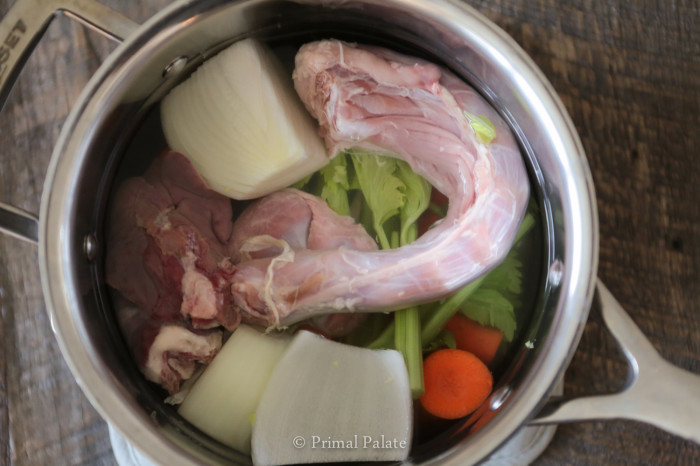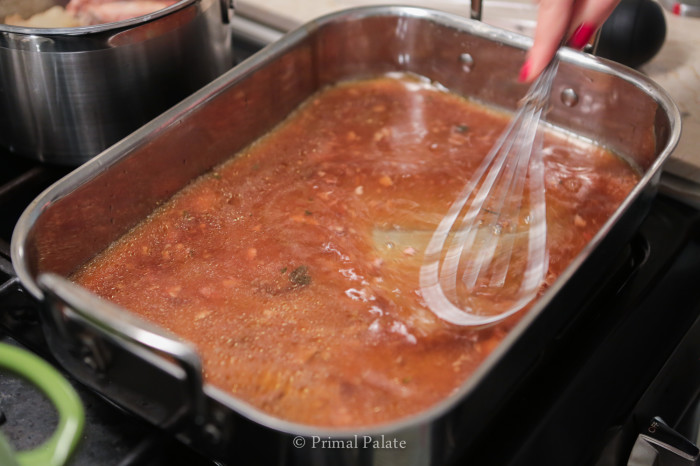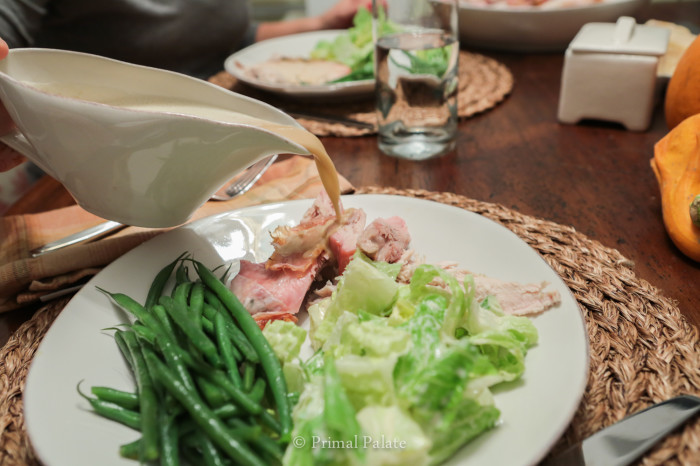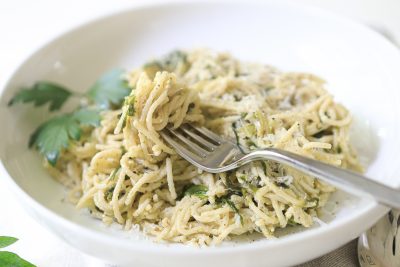When you write a cookbook, you spend days going over edits, and somehow there still end up being errors. One of the errors (or omissions) in Gather is that we forgot to add in the directions for making gravy in the Thanksgiving menu. Sorry about that folks. If you have Gather, and plan on using our recipes, then here is the missing instructions for making gravy. If you don’t have Gather, you can still make our gravy with your turkey, but we definitely recommend you get Gather 🙂 Our gravy recipe is very simple, and quite delicious, but to make the gravy you have to start with a bird and stock. I make my Thanksgiving turkey the way my Grandy taught me, and for that I make a small batch of turkey stock that we use to baste the turkey while it cooks. Our turkey is usually brushed with duck fat or butter before roasting, and I make sure to put some filtered water in the bottom of the roasting pan (about an inch high). The water keeps the drippings from burning, and with the addition of the drippings from the bird, you have a great start to your gravy by having water in the bottom of your roasting pan.  The stock that simmers all day with the bird is simple. I use the giblets and turkey neck, one vidalia onion sliced in half, three large carrots cut in half, and three celery stalks. When I make soup or stock I always add in the leaves of the celery, or the small stalks that have leaves because it adds great flavor, so make sure you throw some of those in as well. I also add a few whole garlic cloves to this stock, and some salt and pepper. Then you want to fill your pot with filtered water, just enough to cover the veggies and giblets is fine, or you can do slightly more. This is a recipe of mine that really doesn’t have measurements, because that’s how my Grandy taught me, so you want to eyeball it for what you think will be enough, depending on the size of your turkey. For a 20 pound turkey I would try to make about six to eight cups of stock. More is more with this recipe, because whatever is left over is just extra broth that you can add to a soup or just drink. The name my family calls this stock is “Gebrutanisht.” I thought this was a Yiddish word, but my Grandy thinks it may be some mix of German and Yiddish that was altered throughout the years, but it was what my Grandpa’s family always called the stock used for the turkey. The recipe changes slightly as the years go on, and I think I make mine slightly different than she makes hers, but either way it’s wonderful.
The stock that simmers all day with the bird is simple. I use the giblets and turkey neck, one vidalia onion sliced in half, three large carrots cut in half, and three celery stalks. When I make soup or stock I always add in the leaves of the celery, or the small stalks that have leaves because it adds great flavor, so make sure you throw some of those in as well. I also add a few whole garlic cloves to this stock, and some salt and pepper. Then you want to fill your pot with filtered water, just enough to cover the veggies and giblets is fine, or you can do slightly more. This is a recipe of mine that really doesn’t have measurements, because that’s how my Grandy taught me, so you want to eyeball it for what you think will be enough, depending on the size of your turkey. For a 20 pound turkey I would try to make about six to eight cups of stock. More is more with this recipe, because whatever is left over is just extra broth that you can add to a soup or just drink. The name my family calls this stock is “Gebrutanisht.” I thought this was a Yiddish word, but my Grandy thinks it may be some mix of German and Yiddish that was altered throughout the years, but it was what my Grandpa’s family always called the stock used for the turkey. The recipe changes slightly as the years go on, and I think I make mine slightly different than she makes hers, but either way it’s wonderful.  I usually start the gebrutanisht about an hour before the turkey goes in the oven. Once all the ingredients are in the pot, you will want to bring the stock to a boil. I let it boil for about 5 minutes, and then I turn it down to low and cover with a cracked lid. You want to the stock to simmer until you start basting, and it continues to simmer during the entire time the turkey is cooking. You typically want to baste your turkey every 30 minutes. We use a turkey baster and just squirt the gebrutanisht over the turkey, very liberally, and a good bit of it will often spill into the bottom of the roasting pan. As you can tell, this stock is not only basting the turkey, but also adding to the drippings in the bottom of the pan. You are really creating layers of flavor by doing this every 30 minutes.
I usually start the gebrutanisht about an hour before the turkey goes in the oven. Once all the ingredients are in the pot, you will want to bring the stock to a boil. I let it boil for about 5 minutes, and then I turn it down to low and cover with a cracked lid. You want to the stock to simmer until you start basting, and it continues to simmer during the entire time the turkey is cooking. You typically want to baste your turkey every 30 minutes. We use a turkey baster and just squirt the gebrutanisht over the turkey, very liberally, and a good bit of it will often spill into the bottom of the roasting pan. As you can tell, this stock is not only basting the turkey, but also adding to the drippings in the bottom of the pan. You are really creating layers of flavor by doing this every 30 minutes. 
 Once your turkey is finished cooking, you should have a good bit of liquid in the bottom of the roasting pan. Once the turkey is removed from the pan, I whisk around the juices in the bottom to make sure anything that settled on the very bottom gets incorporated into the gravy. Then I carefully pour the drippings into our blendtec (you can use a regular blender, or food processor for this also.) Once the gravy liquids are in the blender I add one half of the cooked onion, and one or two cooked celery stalks from the pot that the gebrutanisht cooked in all day. Adding the cooked veggies will not only add flavor, but it will also help to thicken. If there is not enough liquid from the roasting pan, and I have some left over from the gebrutanisht then I will add that to the blender, but if it seems like adding more liquid will make the gravy too thin then I wont. This is really just about eyeballing the gravy for a good thickness, there’s not really a measurement for this. Then I blend it up in our blender and the gravy is ready to serve!
Once your turkey is finished cooking, you should have a good bit of liquid in the bottom of the roasting pan. Once the turkey is removed from the pan, I whisk around the juices in the bottom to make sure anything that settled on the very bottom gets incorporated into the gravy. Then I carefully pour the drippings into our blendtec (you can use a regular blender, or food processor for this also.) Once the gravy liquids are in the blender I add one half of the cooked onion, and one or two cooked celery stalks from the pot that the gebrutanisht cooked in all day. Adding the cooked veggies will not only add flavor, but it will also help to thicken. If there is not enough liquid from the roasting pan, and I have some left over from the gebrutanisht then I will add that to the blender, but if it seems like adding more liquid will make the gravy too thin then I wont. This is really just about eyeballing the gravy for a good thickness, there’s not really a measurement for this. Then I blend it up in our blender and the gravy is ready to serve! 
 This gravy is so simple, and really just feels like it’s part of the cooking process of the turkey-because it is! The turkey and the gravy need each other to really be complete 🙂 You can also do this on a smaller scale with a roasting chicken as well, and we have even used pan drippings from a leg of lamb roast to make gravy (without the stock-just the drippings). This is the way we always make gravy, and the way we always will.
This gravy is so simple, and really just feels like it’s part of the cooking process of the turkey-because it is! The turkey and the gravy need each other to really be complete 🙂 You can also do this on a smaller scale with a roasting chicken as well, and we have even used pan drippings from a leg of lamb roast to make gravy (without the stock-just the drippings). This is the way we always make gravy, and the way we always will.
The Best Thanksgiving Gravy
Latest recipes
Share a recipe
Upload your own recipes to Primal Palate, and help others find great food on our site,, meal planner and app!









Argh. Just seeing this post today. Oh well, the Paleo gravy we came up with for Thanksgiving turned out really well anyway. Thanks for the updated recipe though. 🙂
I used your technique this year, and the turkey was juicy and delicious! I’ll be doing this again from now on! In the past, I’ve found that the turkey didn’t make enough drippings in the bottom of the pan, so there wasn’t much to use to baste the turkey or make gravy. Making a batch of stock on the side to use was brilliant. Thank you!
Hi Jennifer. Thanks for posting. This is our absolute favorite way to make a quick and very flavorful gravy. Happy cooking!
Hello! I’m just popping by to say how much my family has loved this gravy. I found this gravy the year I made my first turkey, in 2015, and have used it every year since. It’s been a hit in my family! This year, because ofCOVID, we cannot gather with our family as we usually do, so I passed this recipe on to my sister in law, who often cooks paleo as we do. She cried at the joy of it!She had to further explain when we chatted later that it was such a simple, but complete recipe: using the stock from the turkey bits to pour on the turkey as it cooks, and then turn into a gravy with no thickening agents…It just astounded her. So, thank you for sharing this family recipe that will be a fixture of at least TWO families for, well, at least our generation. To me, it feels like the kind of recipe I will get to pass down to my children. I don’t have many family recipes, let alone ones which are actually healthy, so it feels extra good to use someone else’s recipe, knowing it, too, is a family heirloom. HappyThanksgiving!